Electrical Response of Photovoltaic Power Cells to Cosmic Radiation in the Stratosphere
Abstract
1. Introduction
2. Experiment Description
2.1. Mechanical Design
2.2. Thermal Design
- Thermal insulation made from 2 cm-thick layers of Styrofoam on each wall (except the glass wall) and one 3 cm-thick layer on the top of the experiment;
- Heaters applied to composite samples and composite boards—3 heaters per board (0.56 W each, total 5 W power), shown in Figure 5;
- A high-emissivity black coating was applied to composite boards’ surfaces, which are shielded from the Sun, to maximise heat flux and equalise temperatures between all composites and composite boards;
- High-reflectance white paint coating was applied to the two surfaces of the composite boards, which are illuminated by the Sun, to reflect most of the incident solar radiation and lower the composites’ temperature;
- Two thermal blankets covering the experiment: one permanently attached to the experiment (on the external side of insulation panels) and the second one covering the experiment on the launch pad and removed as late as possible, so around 30–45 min before launch. For this purpose, isothermal emergency blankets, popularly known as NRC foil or space blankets, were used.
2.3. Electronics and Software Design
- Levels of the ionizing radiation, mainly in beta and gamma spectra from cosmic sources: these readings were used in composite sample analysis and correlation with dark voltages induced on photovoltaic panels;
- Dark voltages induced on solar panels: a voltage generated on a photovoltaic panel terminal while not illuminated by visible light (in a dark state);
- Temperature: this was measured inside the experiment.
3. Experiment Performance
3.1. Correlation with Space Weather Data
3.2. Analysis of X-Ray Influence
3.3. Analysis of Proton Flux Influence
4. Discussion
5. Conclusions
Author Contributions
Funding
Data Availability Statement
Acknowledgments
Conflicts of Interest
References
- Jankiewicz, Z. Balloons and Dirigibles; Publishing House of the Ministry of National Defense: Warsaw, Poland, 1968. [Google Scholar]
- Ginzburg, W.L.; Kurnosova, L.V. The Sun, the cosmic radiation and artificial satellites. In Space Stations: Collection of Articles; USSR Academy of Sciences: Moscow, Russia, 1960. [Google Scholar]
- Neher, H.V.; Anderson, H.R. Cosmic Rays at Balloon Altitudes and the Solar Cycle. J. Geophys. Res. 1962, 67, 1309–1315. [Google Scholar] [CrossRef]
- Mertens, C.J. Initial Results from the Radiation Dosimetry Experiment (RaD-X) Balloon Flight Mission. Available online: https://ntrs.nasa.gov/api/citations/20160006663/downloads/20160006663.pdf (accessed on 17 November 2024).
- Isakov, P. Life on an artificial satellite. In Space Stations: Collection of Articles; USSR Academy of Sciences: Moscow, Russia, 1960. [Google Scholar]
- Rosenzweig, W. Space radiation effects in silicon devices. IEEE Trans. Nucl. Sci. 1965, 12, 18–29. [Google Scholar] [CrossRef]
- Sarles, F.W., Jr.; Stanley, A.G.; Roberge, J.K.; Godfrey, B.W. Space radiation damage measurements in the Earth synchronous orbit. IEEE Trans. Aerosp. Electron. Syst. 1973, AES-9, 921–924. [Google Scholar] [CrossRef]
- Home, W.E.; Wilkinson, M.C. Improved model for predicting space performance of solar cells. IEEE Trans. Nucl. Sci. 1974, 21, 130–137. [Google Scholar] [CrossRef]
- Guidice, D.A. PASP PLUS: An experiment to measure space-environment effects on photovoltaic power subsystems. In Proceedings of the 5th Annual Workshop on Space Operations Applications and Research (SOAR 1991), Houston, TX, USA, 9–11 July 1991; N92-22362. NASA Technical Reports Server: Houston, TX, USA, 1992; pp. 662–668. [Google Scholar]
- Vogl, T.; Sripathy, K.; Sharma, A.; Reddy, P.; Sullivan, J.; Machacek, J.R.; Zhang, L.; Karouta, F.; Buchler, B.C.; Doherty, M.W.; et al. Radiation tolerance of two-dimensional material-based devices for space applications. Nat. Commun. 2019, 10, 1202. [Google Scholar] [CrossRef]
- Gussenhoven, M.S.; Mullen, E.G.; Hardy, D.A.; Madden, D.; Holeman, E.; Delorey, D.; Hanser, F. Low altitude edge of the inner radiation belt: Dose models from the APEX satellite. IEEE Trans. Nucl. Sci. 1995, 42, 2035–2042. [Google Scholar] [CrossRef]
- Guiot, P.; Vicendon, M.; Carter, J.; Langevin, Y.; Carapelle, A. Characterization of transient signal induced in IR detector array by Jupiter high-energy electrons and implications for JUICE/MAJIS operability. Planet. Space Sci. 2020, 181, 104782. [Google Scholar] [CrossRef]
- Garrett, H.; Jun, I.; Evans, R.; Kim, W.; Brinza, D. The latest Jovian-trapped proton and heavy ion models. IEEE Trans. Nucl. Sci. 2017, 64, 2802–2813. [Google Scholar] [CrossRef]
- Pankratov, B.M. Descent Vehicles; Mashinostroyeniye: Moscow, Russia, 1984. [Google Scholar]
- Oster, L. Modern Astronomy; PWN: Warsaw, Poland, 1982. [Google Scholar]
- Cahen, G.; Treille, P. Fundamentals of Nuclear Energy; PWN: Warsaw, Poland, 1959. [Google Scholar]
- Miley, G.H.; Krupakar Murali, S. Inertial Electrostatic Confinement (IEC) Fusion: Fundamentals and Applications; Springer Science+Business Media: New York, NY, USA, 2014. [Google Scholar]
- Głuszewski, W. From radiation sterilization to polymer modification. Prog. Nucl. Phys. 2023, 66, 21–27. [Google Scholar]
- Imnguimbert, C.; Messenger, S. Equivalent displacement damage dose for on-orbit space applications. IEEE Trans. Nucl. Sci. 2012, 59, 3117–3125. [Google Scholar] [CrossRef]
- Joliot-Curie, I. Natural Radioactive Elements; PWN: Warsaw, Poland, 1954. [Google Scholar]
- Hadrami, M.; Roubi, L.; Zazoui, M.; Bourgoin, J.C. Relation between solar cell parameters and space degradation. Sol. Energy Mater. Sol. Cells 2006, 90, 1486–1497. [Google Scholar] [CrossRef]
- Makham, S.; Sun, G.C.; Bourgoin, J.C. Modelling of solar cell degradation in space. Sol. Energy Mater. Sol. Cells 2010, 94, 971–978. [Google Scholar] [CrossRef]
- Li, P.; Dong, H.; Lan, J.; Bai, Y.; He, C.; Ma, L.; Li, Y.; Liu, J. Tolerance of perovskite solar cells under proton and electron irradiation. Materials 2021, 15, 1393. [Google Scholar] [CrossRef] [PubMed]
- Verduci, R.; Romano, V.; Brunetti, G.; Yaghoobi Nia, N.; Di Carlo, A.; D’Angelo, G.; Ciminelli, C. Solar energy in space applications: Review and technology perspectives. Adv. Energy Mater. 2022, 12, 2200125. [Google Scholar] [CrossRef]
- Šamić, H.; Makham, S. The influence of radiation on the solar cell efficiency. Balk. J. Electr. Comput. Eng. 2014, 2, 2–5. [Google Scholar]
- Karazhanov, S.Z. Mechanism for the anomalous degradation of proton- or electon-irradiated silicon solar cells. Sol. Energy Mater. Sol. Cells 2011, 69, 53–60. [Google Scholar] [CrossRef]
- Curtin, D.J.; Statler, R.L. Review of radiation damage to silicon solar cells. IEEE Trans. Aerosp. Electron. Syst. 1974, AES-11, 499–513. [Google Scholar] [CrossRef]
- Hands, A.D.P.; Ryden, K.A.; Meredith, N.P.; Glauert, S.A.; Horne, R.B. Radiation effects on satellites during extreme space weather events. Space Weather 2018, 16, 1216–1226. [Google Scholar] [CrossRef]
- Lozinski, A.R.; Horne, R.B.; Glauert, S.A.; Del Zanna, G.; Claudepierre, S.G. Modelling inner proton belt variability at energies 1 to 10 MeV using BAS-PRO. J. Geophys. Res. Space Phys. 2021, 126, e2021JA029777. [Google Scholar] [CrossRef]
- Burrell, M.O. The Calculation of Proton Penetration and Dose Rates; NASA Technical Memorandum TM X-53063, 17 August 1964; NASA: Washington, DC, USA, 1964. [Google Scholar]
- Srour, J.R.; Vendura, G.J., Jr.; Lo, D.H.; Toporow, C.M.C.; Dooley, M.; Nakano, R.P.; King, E.E. Damage mechanisms in radiation-tolerant amorphous silicon solar cells. IEEE Trans. Nucl. Sci. 1998, 45, 2624–2631. [Google Scholar] [CrossRef]
- Summers, G.P.; Messenger, S.R.; Burke, E.A.; Xapsos, M.A.; Walters, R.J. Contribution of low-energy protons to degradation of shielded GaAs solar cells in space. Prog. Photovolt. Res. Appl. 1997, 5, 407–413. [Google Scholar] [CrossRef]
- Toda, H.; Miyake, W.; Miyoshi, Y.; Toyota, H.; Miyazawa, Y.; Shinohara, I.; Matsuoka, A. Spatial distribution of radiation belt protons deduced from solar cell degradation of the Arase satellite. Int. J. Astron. Astrophys. 2018, 8, 306–322. [Google Scholar] [CrossRef][Green Version]
- Pellicori, S.F.; Martinez, C.L.; Haugsen, P.; Wilt, D. Development and testing of coatings for orbital space radiation environment. Appl. Opt. 2014, 53, A339–A350. [Google Scholar] [CrossRef]
- Bogatov, N.M.; Grigor’yan, L.R.; Kovalenko, A.I.; Kovalenko, M.S.; Lunin, L.S. Pulse response characteristics of silicon photovoltaic converters irradiated with low-energy protons. Tech. Phys. Lett. 2021, 47, 326–328. [Google Scholar] [CrossRef]
- Verkerk, A.D.; Rath, J.K.; Schropp, R.E.I. Degradation of thin film nanocrystalline silicon solar cells with 1 MeV protons. Energy Procedia 2010, 2, 221–226. [Google Scholar] [CrossRef]
- Messenger, S.R.; Burke, E.A.; Walters, R.J.; Warner, J.H.; Summers, G.P.; Morton, T.L. Effect of omnidirectional proton irradiation on shielded solar cells. IEEE Trans. Nucl. Sci. 2006, 53, 3771–3778. [Google Scholar] [CrossRef]
- Imaizumi, M.; Ohshima, T.; Yuri, Y.; Suzuki, K.; Ito, Y. Effects of beam conditions in ground irradiation tests on degradation of photovoltaic characteristics of space solar cells. Quantum Beam Sci. 2021, 5, 15. [Google Scholar] [CrossRef]
- Sato, S.; Sai, H.; Ohshima, T.; Imaizumi, M.; Shimazaki, K.; Kondo, M. Temperature influence on performance degradation of hydrogenated amorphous silicon solar cells irradiated with protons. Prog. Photovolt. Res. Appl. 2013, 21, 1499–1506. [Google Scholar] [CrossRef]
- Amekura, H.; Kishimoto, N.; Kono, K. Radiation-induced two-step degradation of Si photoconductors and space solar cells. IEEE Trans. Nucl. Sci. 1998, 45, 1508–1513. [Google Scholar] [CrossRef]
- Dorabialska, A. Natural Radioactivity of Chemical Compounds; PZWS: Warsaw, Poland, 1952. [Google Scholar]
- Skłodowska-Curie, M. Radioactivity; OFPW: Warsaw, Poland, 2011; (Reprint 1939). [Google Scholar]
- Broda, E.; Schönfeld, T. Application of Radioactivity in Technology; PWN: Warsaw, Poland, 1959. [Google Scholar]
- Tamošiūnas, V.; Minkevičius, L.; Vaitkūnas, A.; Urbanowicz, A.; Maneikis, A.; Šetkus, A.; Valušis, G. Characterization of silicon solar cells and module materials using terahertz radiation. Energy Procedia 2015, 77, 202–207. [Google Scholar] [CrossRef][Green Version]
- Tippabhotla, S.K.; Song, W.J.R.; Subramani, A.; Stan, C.V.; Tamura, N.; Tay, A.A.O.; Budiman, A.S. Stress and fracture of crystalline silicon cells in solar photovoltaic modules—A synchrotron X-ray microdiffraction based investigation. MRS Adv. 2019, 4, 2319–2335. [Google Scholar] [CrossRef]
- National Oceanic and Atmospheric Administration’s Space Weather Prediction Center. Available online: https://www.swpc.noaa.gov/ (accessed on 24 October 2024).
- Nowakowski, W. Fundamental Electronic Circuits; Impulse Circuits; WKiŁ: Warsaw, Poland, 1982. [Google Scholar]
- Butera, S.; Lioliou, G.; Barnett, A.M. gallium arsenide Fe-55 X-ray photovoltaic battery. J. Appl. Phys. 2016, 119, 064504. [Google Scholar] [CrossRef]
- The REXUS/BEXUS Programme. Rocket and Balloon Experiments for University Students. Available online: https://rexusbexus.net/ (accessed on 4 February 2025).
- BEXUS User Manual, Version 8.1; REXUS/BEXUS Programme; Kiruna, Sweden. 2023. Available online: https://rexusbexus.net/wp-content/uploads/2025/01/BX_REF_BEXUS_User-Manual_v8-2_26Dec24.pdf (accessed on 5 February 2025).
- Student Experiment Documentation: BX35 CURiE SED v4.1. 22 September 2024.
- Goldstein, H. Fundamental Aspects of Reactor Shielding; Gosatomizdat: Moscow, Russia, 1961. [Google Scholar]
- Hubbell, J.H.; Seltzer, S.M. Tables of X-ray Mass Attenuation Coefficients and Mass Energy-Absorption Coefficients from 1 keV to 20 MeV for Elements Z = 1 to 92 and 48 Additional Substances of Dosimetric Interest. In NIST Standard Reference Database 126; NIST: Gaithersburg, MD, USA, 2004. [Google Scholar] [CrossRef]
- NIST PSTAR: Stopping-Power and Range Tables for Protons. Available online: https://physics.nist.gov/PhysRefData/Star/Text/PSTAR.html (accessed on 5 November 2024).
- Araminowicz, J.; Małuszyńska, K.; Przytuła, M. Laboratory of Nuclear Physics; PWN: Warsaw, Poland, 1978. [Google Scholar]
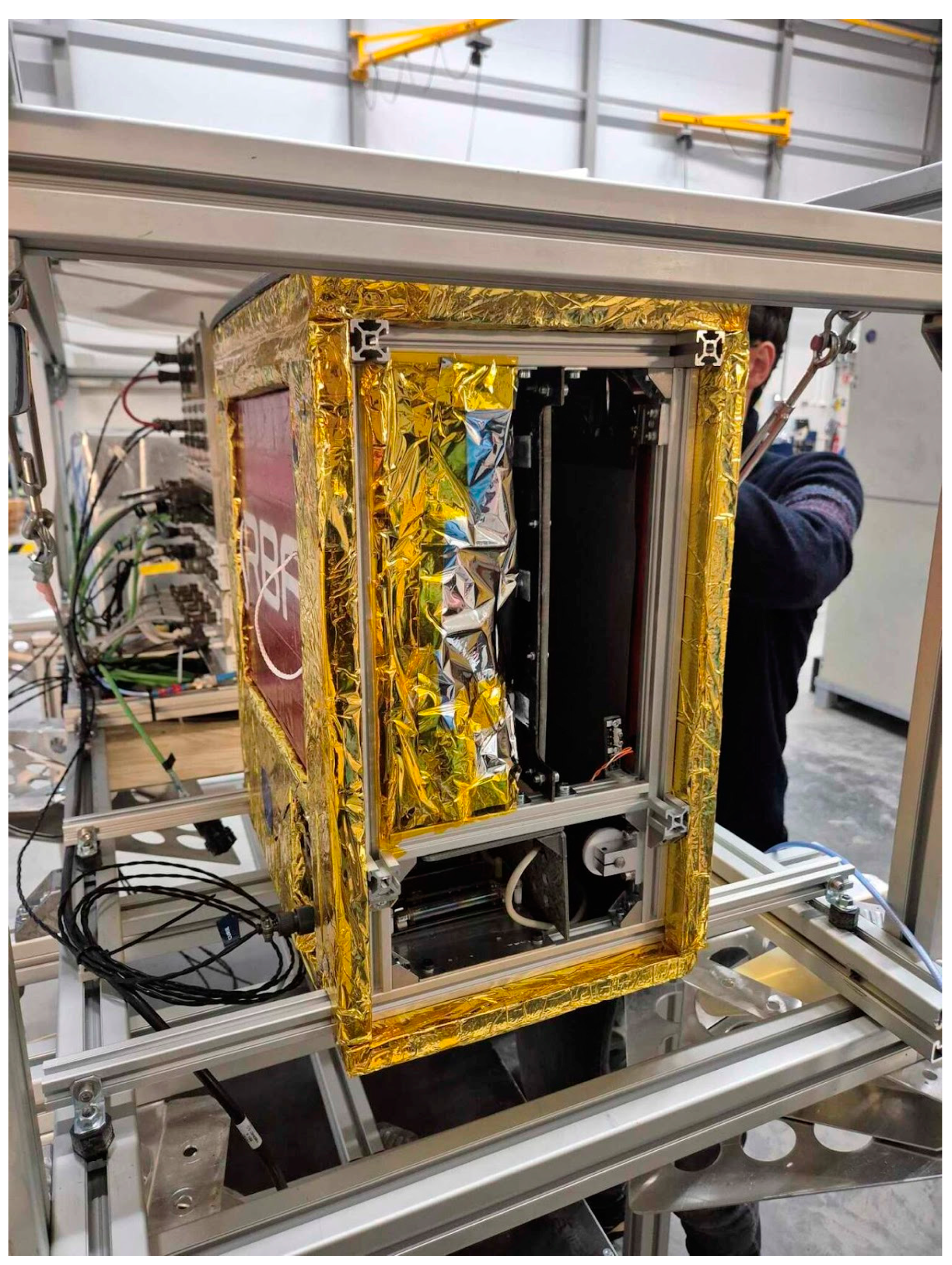
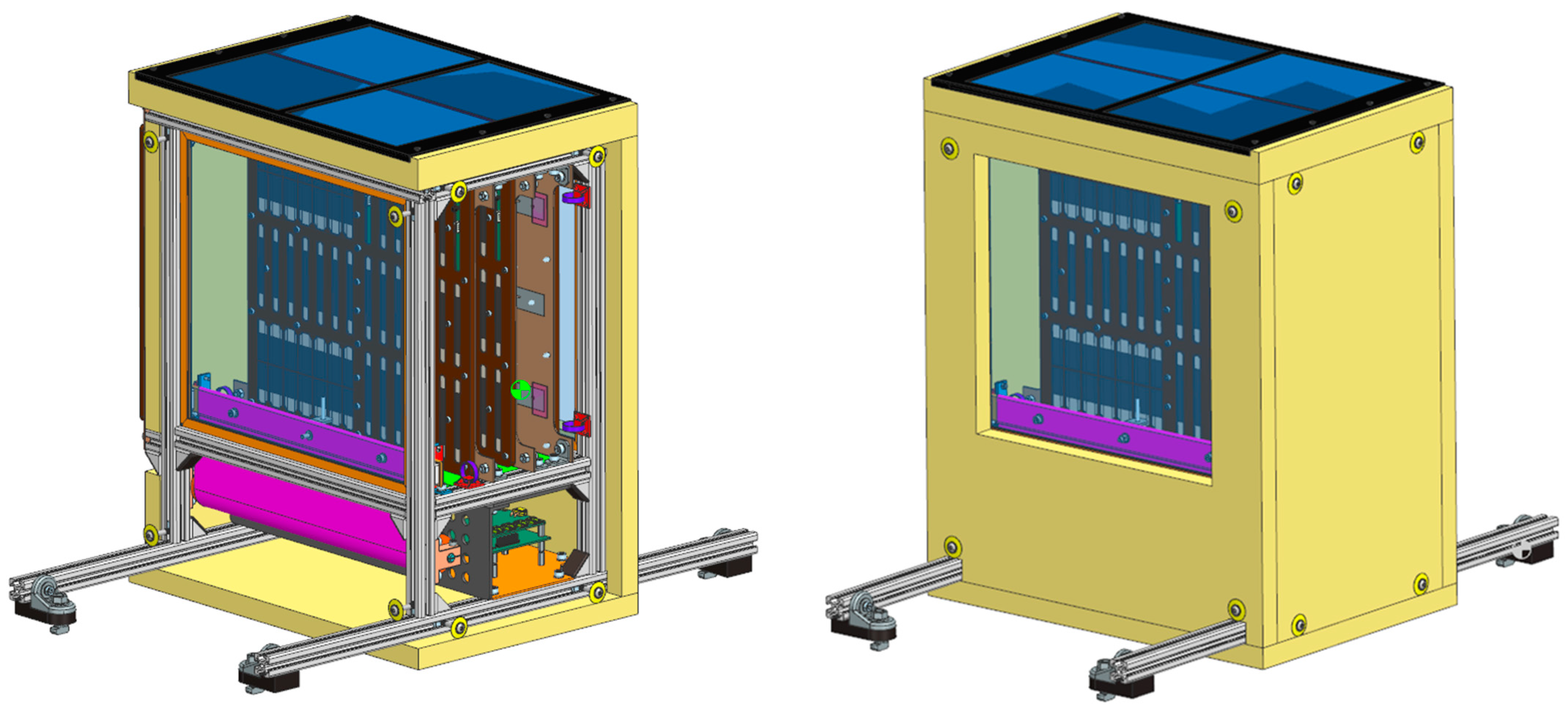
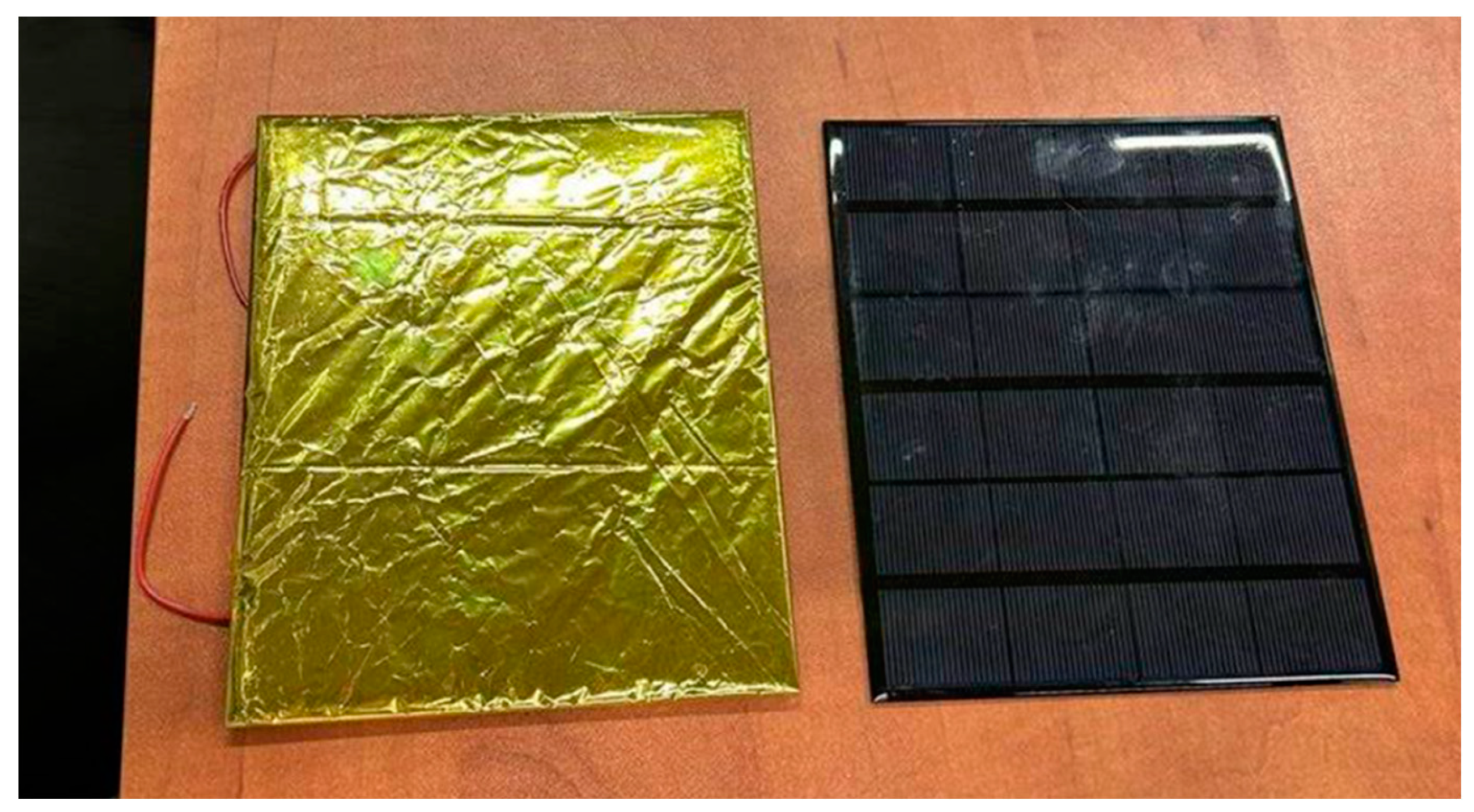



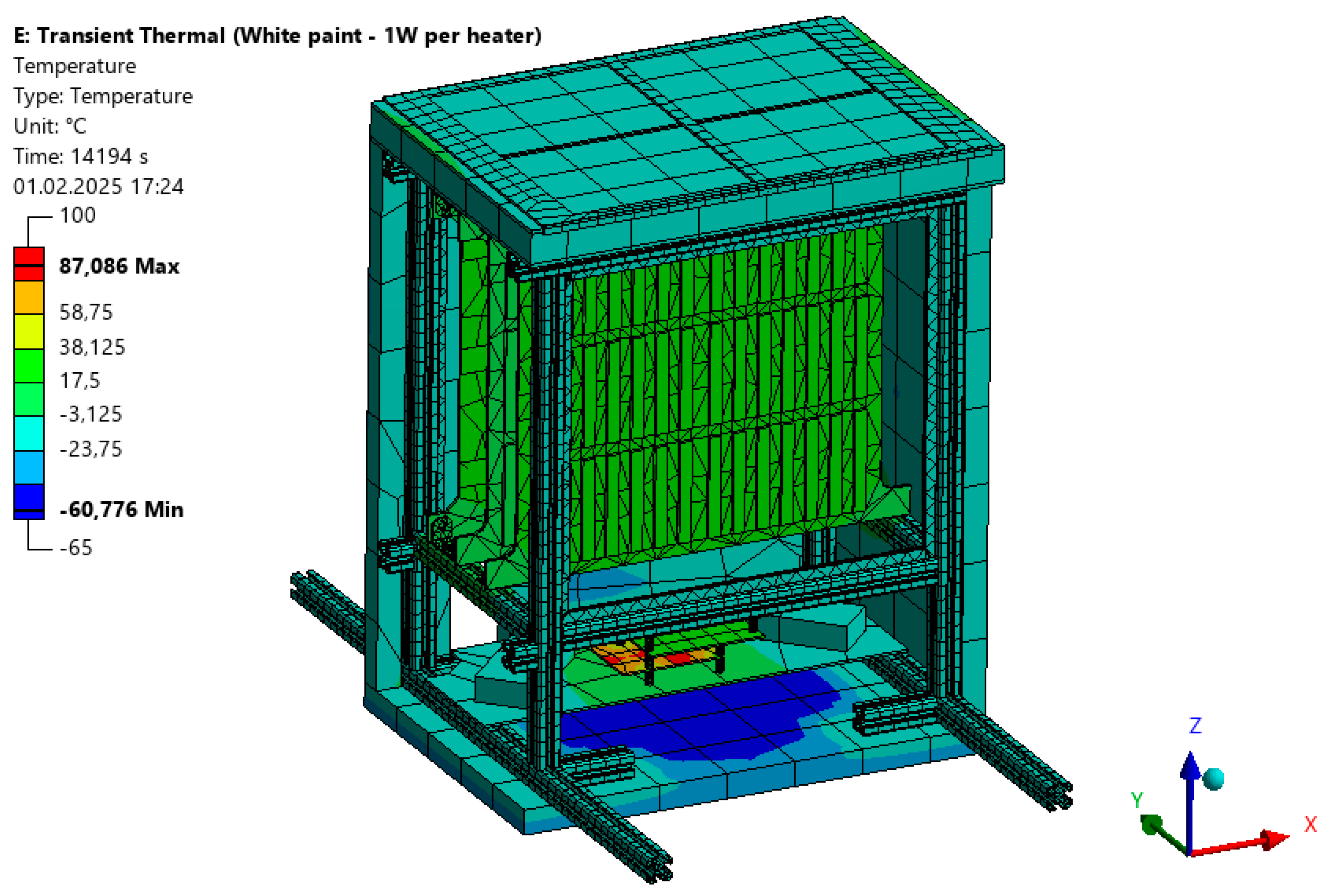




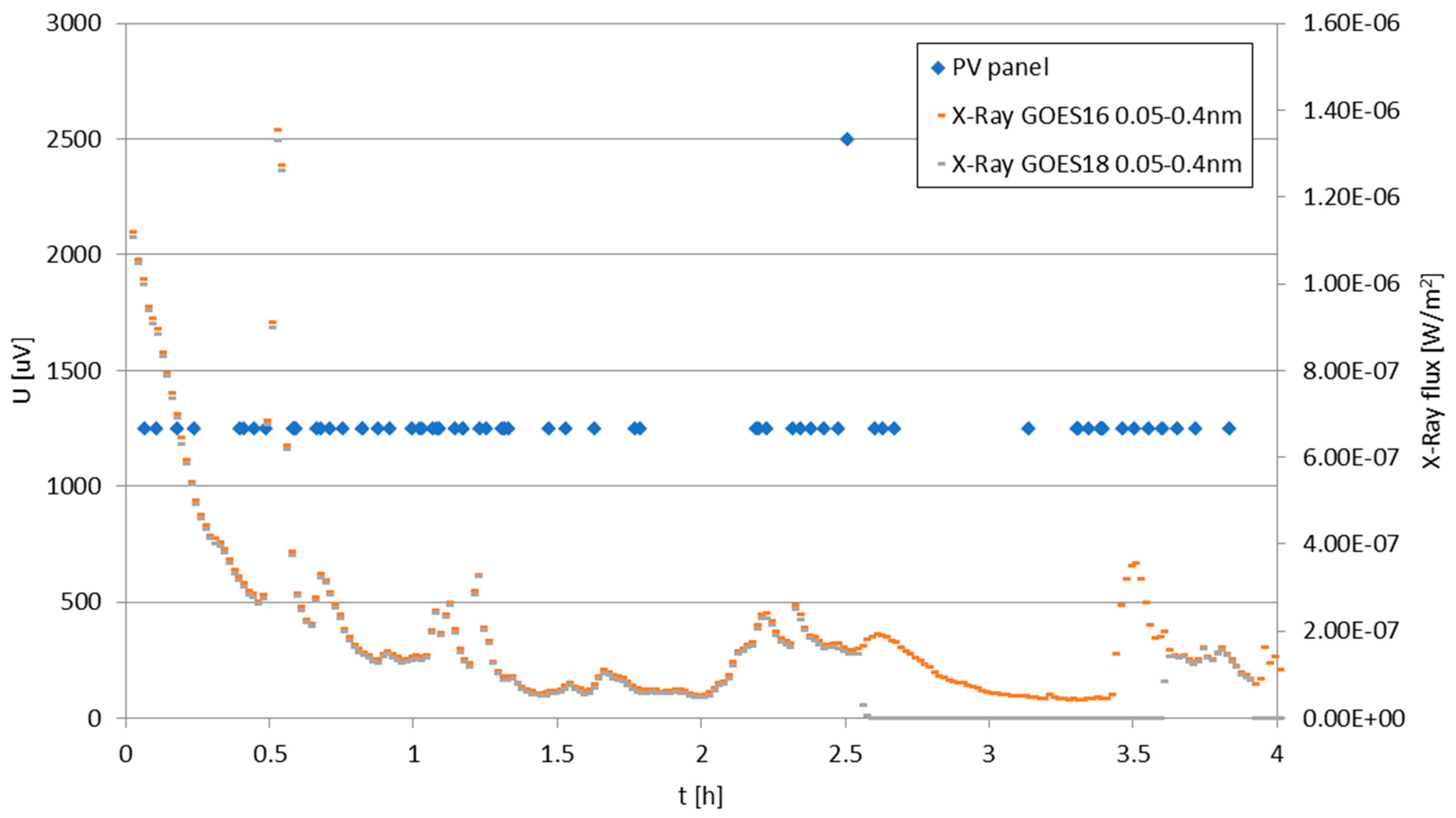

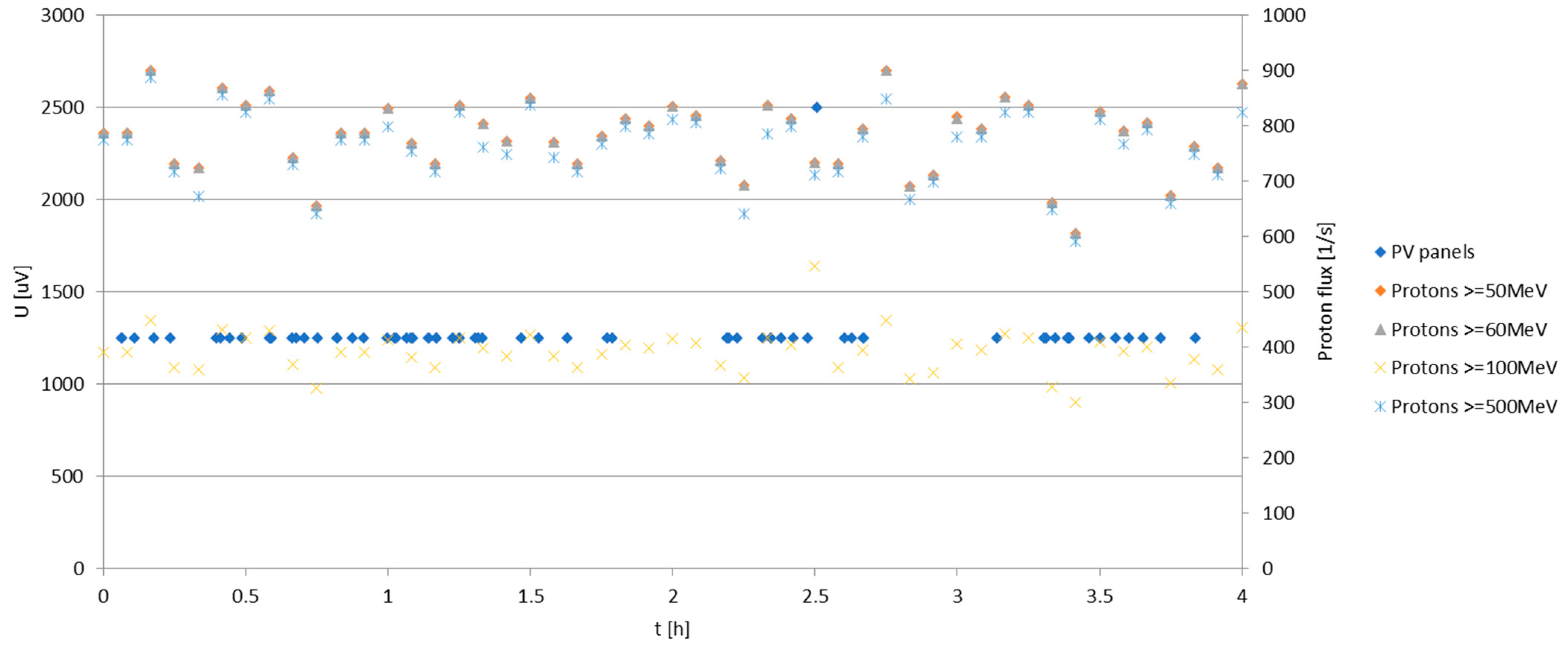

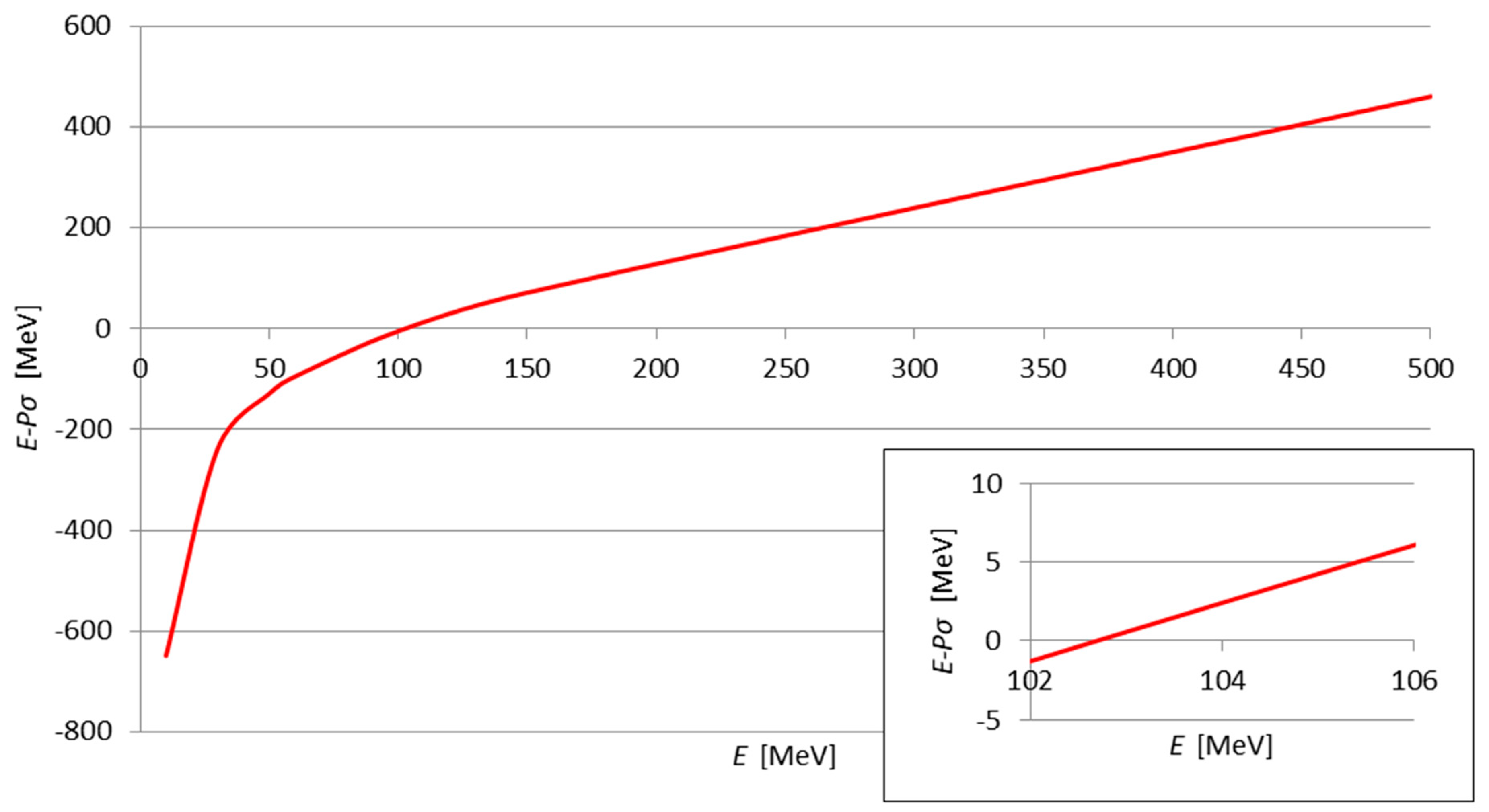
| 2 October 2024, Local Time | BX35 Mission Event |
|---|---|
| 09.53.15 | BX35 launch from Esrange (Sweden) |
| 10.04 | CURiE panels generate the first voltage signals |
| 11.28 | Beginning of float phase, stabilizing altitude: 27.4–27.6 km |
| 15.03 | Balloon cut off, beginning of re-entry |
| 15.28 | Descending, altitude: 3926 m |
| 15.32 | Loss of signal, altitude: 2084 m |
| 15.41 | BX35 landing confirmed (Finland) |
| λ [nm] | E [keV] | µ [m2/kg] | e−µσ |
|---|---|---|---|
| 0.05 | 24.8 | 0.00025 | 0.960 |
| 0.1 | 12.4 | 0.0002 | 0.968 |
| 0.4 | 3.1 | 0.003 | 0.613 |
| 0.8 | 1.55 | 0.003 | 0.6132 |
| λ [nm] | E [keV] | µ [m2/kg] | e−µσ |
|---|---|---|---|
| 0.05 | 24.8 | 0.065 | 0.997 |
| 0.1 | 12.4 | 0.12 | 0.995 |
| 0.4 | 3.1 | 1 | 0.960 |
| 0.8 | 1.55 | 3.5 | 0.868 |
| E [MeV] | P [MeV × m2/kg] | P × σ [MeV] | E-P × σ [MeV] | R [kg/m2] | R > 163 kg/m2 ? |
|---|---|---|---|---|---|
| 10 | 4.006 | 652.978 | −648.972 | 1.405 | NO |
| 30 | 1.653 | 269.439 | −238.439 | 10.05 | NO |
| 50 | 1.099 | 179.137 | −129.137 | 25.24 | NO |
| 60 | 0.9517 | 155.1271 | −95.1271 | 35.04 | NO |
| 100 | 0.6443 | 105.0209 | −5.0209 | 87.31 | NO |
| 150 | 0.4816 | 78.5008 | 71.4992 | 178.3 | YES |
| 500 | 0.2431 | 39.6253 | 460.3747 | 1320 | YES |
Disclaimer/Publisher’s Note: The statements, opinions and data contained in all publications are solely those of the individual author(s) and contributor(s) and not of MDPI and/or the editor(s). MDPI and/or the editor(s) disclaim responsibility for any injury to people or property resulting from any ideas, methods, instructions or products referred to in the content. |
© 2025 by the authors. Licensee MDPI, Basel, Switzerland. This article is an open access article distributed under the terms and conditions of the Creative Commons Attribution (CC BY) license (https://creativecommons.org/licenses/by/4.0/).
Share and Cite
Miś, T.A.; Pytlak, D.; Kościanek, B.; Szalkowski, K.; Czerniej, J.; Kucharczyk, P.; Salamon, M.; Pąśko, M.; Styrna, K.; Wąsowska, S.; et al. Electrical Response of Photovoltaic Power Cells to Cosmic Radiation in the Stratosphere. Electronics 2025, 14, 991. https://doi.org/10.3390/electronics14050991
Miś TA, Pytlak D, Kościanek B, Szalkowski K, Czerniej J, Kucharczyk P, Salamon M, Pąśko M, Styrna K, Wąsowska S, et al. Electrical Response of Photovoltaic Power Cells to Cosmic Radiation in the Stratosphere. Electronics. 2025; 14(5):991. https://doi.org/10.3390/electronics14050991
Chicago/Turabian StyleMiś, Tomasz Aleksander, Dominika Pytlak, Bartosz Kościanek, Korneliusz Szalkowski, Jakub Czerniej, Paulina Kucharczyk, Mikołaj Salamon, Marek Pąśko, Karolina Styrna, Sandra Wąsowska, and et al. 2025. "Electrical Response of Photovoltaic Power Cells to Cosmic Radiation in the Stratosphere" Electronics 14, no. 5: 991. https://doi.org/10.3390/electronics14050991
APA StyleMiś, T. A., Pytlak, D., Kościanek, B., Szalkowski, K., Czerniej, J., Kucharczyk, P., Salamon, M., Pąśko, M., Styrna, K., Wąsowska, S., Gołąb, M., Urbański, P., Tronowski, H., & Legutko, D. (2025). Electrical Response of Photovoltaic Power Cells to Cosmic Radiation in the Stratosphere. Electronics, 14(5), 991. https://doi.org/10.3390/electronics14050991





